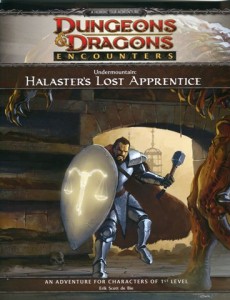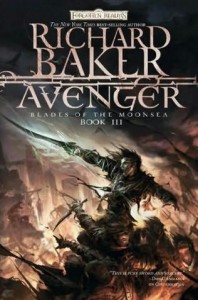 With the release of the PHB3 we have four new player character races to add to our available choices. Today I want to consider the Shardmind, beings of raw psionic energy barely contained in a body of gleaming crystalline shards.The Shardmind is built for the purpose of supporting the new psionic power source classes. Of course the Shardmind is also capable of doing much more than this as the player can select how they’d like their ability scores distributed. I’m of mixed minds about the Shardmind, part of me wants to love this race, another part isn’t too sure.
With the release of the PHB3 we have four new player character races to add to our available choices. Today I want to consider the Shardmind, beings of raw psionic energy barely contained in a body of gleaming crystalline shards.The Shardmind is built for the purpose of supporting the new psionic power source classes. Of course the Shardmind is also capable of doing much more than this as the player can select how they’d like their ability scores distributed. I’m of mixed minds about the Shardmind, part of me wants to love this race, another part isn’t too sure.
Tag: Dungeons and Dragons
D&D Encounters (Weeks 3 & 4)
 D&D Encounters is a 12-part adventure from Wizards of the Coast and it’s played out one encounter each week over the next 12 weeks.
D&D Encounters is a 12-part adventure from Wizards of the Coast and it’s played out one encounter each week over the next 12 weeks.
What’s in store for seasons two and three of the D&D Encounters program? We have some rumours and some facts. But first, our ongoing coverage continues as we share our thought and feedback from D&D Encounters (weeks 3 & 4).
Time in D&D
Raise your hand if you’ve ever created a level 1 PC, entered a dungeon, killed a bunch of monsters, gained a bunch of levels while still inside the dungeon and then realized that only a few weeks of actual in-game time passed when you emerge. I know I’m not the only one reading this that has his hand up.
Time in D&D is an aspect of the game I find is overlooked way too often. Tracking time in your game may not be that big a deal, but the longer you continue playing that same PC the more important time becomes.
So just how long does it take to go from level 1 to level 2? In 4e D&D it takes about 10-13 encounters or about four gaming sessions. But what I really want to know is how much time passes in-game between levels?
Is having a good time reward enough for playing D&D? Hell no! I want treasure and I want XP. I’ve earned it. Gimme, gimme, gimme. I’ll admit that as a player I fall pretty squarely into this camp. Having a good time and socializing with friends is a great part of playing D&D, but what I look forward to most at the end of the session is the reward. And thanks to the mechanics of 4e D&D I’m rarely disappointed.
The rules for rewarding players are so simple and streamlined that I know at the start of the night what I can expect by the end of the night. I’m not saying that this is a bad thing at all. By having some general foreknowledge of what I’m risking my PC’s life for, I’m more strongly motivated to rush headlong into a fight with a dragon or attempt to decipher the ancient glyphs protecting the entrance to the lost treasure trove.
The Miracle Of Divine Power
 Divine Sight, Voice of Fate, Water Walk, Travelers’ Feast, Cure Disease, Remove Affliction and Raise Dead.
Divine Sight, Voice of Fate, Water Walk, Travelers’ Feast, Cure Disease, Remove Affliction and Raise Dead.
All rituals.
All miracles.
I’ve always enjoyed the fact that rather than create new spells and powers for divine characters, D&D draws its inspiration from the major faiths that exist today. All of the rituals above are found in the Bible in one form or another. As it’s the day after Easter when the Christian faith celebrates the major miracle of its faith, I thought it only appropriate to take a look at the Divine Power source.
Month in Review: March 2010
March was a great month for D&D and for Dungeon’s Master. Wizards of the Coast released the Player’s Handbook 3 and they began the new D&D Encounters program. Our article on D&D Encounters (Week 1) was referenced on the Wizards site in their D&D in the News article from Monday, March 22. They also linked to Dungeon’s Master from the Dungeons & Dragons Facebook page. We always appreciate it when we get a shout out from Wizards. For readers who found us through these links, we welcome you to Dungeon’s Master. On the 1st of every month we do a round-up of all the article we published in the previous month. This gives everyone a chance to check out any of the articles that they might have missed the first time around.
Review: Avenger
 Avenger
Avenger
(Blades of the Moonsea, Book III)
Richard Baker
A Forgotten Realms novel
Avenger is the third adventure featuring Garen Hulmaster. The Blades of Moonsea trilogy comes to a thrilling conclusion in Avenger. The Hulmasters were usurped from their family stronghold and forced to flee Hulberg at the end of Corsair, the second novel. Avenger picks up a few months later as the Hulmasters are struggling to devise a plan to retake their home. But before any plans can be enacted, the family is struck upon by assassins.
One of the first articles published at Dungeon’s Master was our series on the Necromancer. It started as a way of addressing the lack of specialist Wizards in 4e D&D. As one of our oldest articles, our series on the Necromancer continues to see regular traffic from a variety of sources. The idea of expanding the Necromancer beyond the Wizard class is one that I’ve had for some time now. The Warlock is a natural fit for the Necromancer.
Nothing speaks of a deal for power, as making a pact with death itself. The Death Pact Necromancer does just that, trading their soul for power and a command over death.
I think we inadvertently angered a lot of DMs with our series on items that provide energy resistances. Few players needed our help min/maxing and power-gaming, yet over the past couple of weeks the Dungeon’s Master team made it immensely easier for PCs to find items that will protect them from various energy attacks. Today we’re going to set things right. The final installment of this series is geared specifically at the DM. We’ve analysed the item lists across heroic, paragon and epic tiers and offer some advice to DMs on how to best use energy-specific attacks.
At heroic tier energy resistance is nice to have. At paragon tier it becomes a little bit more important. And at epic tier energy resistance is a must. If a party wants to have any chance at surviving multiple encounters between extended rests then they need to avoid damage, and energy resistance will help you there.